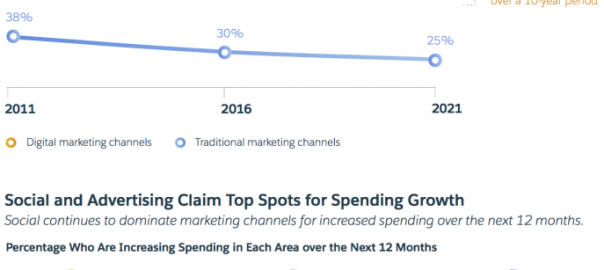Newest “State of Marketing” report describes what approaches characterize high-performing marketing teams.

It’s all about customer satisfaction.
That approach, which is increasingly becoming accepted wisdom among digital marketers, is confirmed in Salesforce’s newest “State of Marketing” report, out today.
Thirty-five percent of surveyed marketers cited customer satisfaction as their top success metric, edging out the traditional goals of revenue (33 percent) and customer acquisition (24 percent). This is the second year in a row that customer satisfaction has maintained this top position.
Customer satisfaction has become the top goal of many digital marketers, in large part because of digital technologies. When a comparably priced service or a product of similar quality is available within a few clicks, as it for many offerings, then keeping customers requires that they have positive feelings about their dealings with the brand.
Customer satisfaction is derived from customer experience, which Salesforce defines as “all the interactions between a brand and its customers.” Maintaining the quality of all those interactions requires marketers to track those experiences across a customer journey.
As with many other vendors and marketers, customer journeys are a key aspect of the Salesforce universe. Its Marketing Cloud, for instance, is built around a Journey Builder for tracking these experiences.
The new report found that, among high-performing marketing teams, more than half — 65 percent — have adopted a customer journey approach, and 88 percent of those defined it as “critical” to their success.
The report asked the surveyed marketers to self-assess their performance. The results: 18 percent self-described as high performers, 68 percent as moderate performers, and 14 percent as underperformers.
To characterize yourself as a high performer, the survey said, you had to be able to assert you were “extremely satisfied” with the current outcomes from your marketing investments.

More than ever, those investments are in digital. 2016 “marks a tipping point as marketers now spend three-quarters of their marketing budgets on online channels,” Salesforce Chief Digital Evangelist Vala Afshar told me. That is an increase from 70 percent and 62 percent in the last two years.
High performers, according to the report, are more likely to have customer satisfaction as a first priority, often employ a customer journey strategy and have imbued a consistent customer experience across the company.
They are also more likely to have buy-in from C-suite execs, to have aligned the various digital channels while marketing cross-channel, to use customer data for targeting, to lead digital transition efforts across a company and to use customer relationship management (CRM) systems and predictive analytics.
Some other findings in the report:
— Email has been called a workhorse so often, we could almost adopt a muscular and burdened image of this animal as its symbol. And the report continues to bear this out, with 80 percent of those using email marketing saying it is central to their operation. Almost half now connect it directly to their business’s primary revenue source, which Salesforce notes is a 140-percent increase over last year’s finding.

— Among high performers, 63 percent personalize emails, and 48 percent send the same email to everyone but with unique content for specific segments. “What is breathing life into workhorse email,” Afshar noted, is its “precise use” through such techniques as personalized content.
— The 75 percent who use social marketing and report that it is generating return-on-investment (ROI) represent a 166-percent increase over last year’s report. The most effective social channel is — no surprise — Facebook, followed by Twitter, YouTube, Google+ (a surprise ranking) and Instagram. More marketers are advertising on social than on other digital channels.
— Mobile similarly is showing big boosts, with 100 percent or more increases among marketers, who cite the use of location-based mobile tracking, mobile push notifications, mobile text messaging and mobile apps.
— Salesforce, best known for its CRM system, points out that 84 percent of high performers use email addresses or other data from their CRM to segment or target their ads, such as direct targeting or lookalike matching of those leads on Facebook. This compares to only 57 percent of underperformers who do the same.
Almost 4,000 digital marketers across the globe were surveyed anonymously in early 2016 by a third-party research firm for this report. Salesforce said that using its products, or even another marketing suite, was not a precondition, although they had to be using some digital marketing tools.






